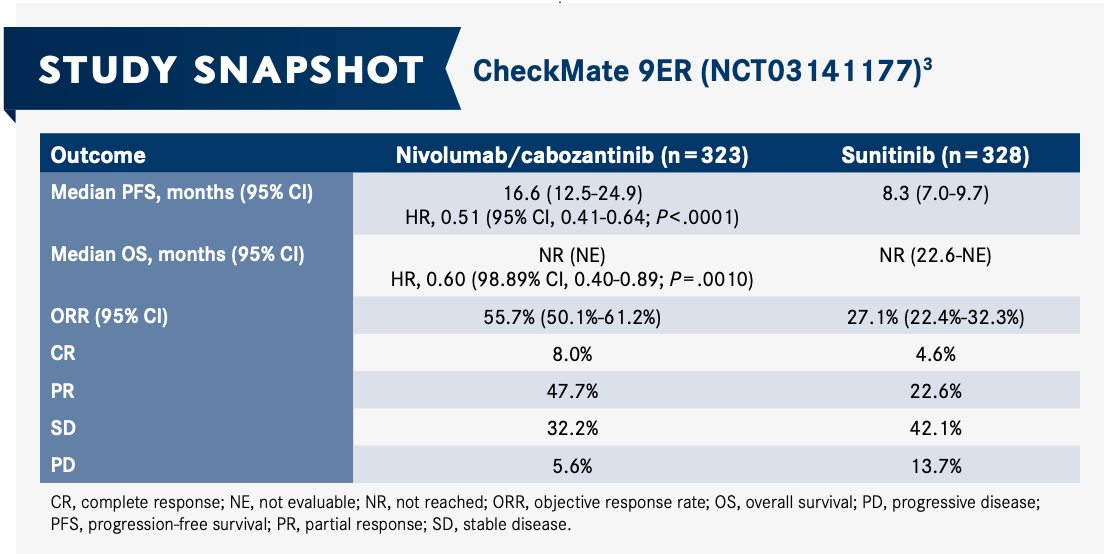Article
Immuno-Oncology Combinations Dominate in Frontline Treatment of Advanced Clear Cell RCC
Author(s):
During a recent OncLive Peer Exchange®, a panel of experts in kidney cancer from the United States and France convened to discuss several important immunotherapy studies presented during the ESMO Virtual Congress 2020, as well as several others that are under way and expected to report out over the next few years.
Rana R. McKay, MD

Until 2018, when nivolumab (Opdivo) and ipilimumab (Yervoy) were approved for treatment-naïve patients with intermediate- or poor-risk metastatic renal cell carcinoma (mRCC), monotherapy with a VEGF tyrosine kinase inhibitor (TKI) was considered the frontline standard of care.1 Since that approval, the immuno-oncology (IO) landscape has expanded across mRCC risk groups, and that growth is poised to continue.
During a recent OncLive Peer Exchange®, a panel of experts in kidney cancer from the United States and France convened to discuss several important IO studies presented during the European Society for Medical Oncology (ESMO) Virtual Congress 2020, as well as several others that are under way and expected to report out over the next few years. The panelists also discussed some of the knowledge gaps that remain in managing mRCC, including a paucity of meaningful biomarkers to guide treatment decision-making, and how they sequence treatments for their patients despite these gaps.
CheckMate-9ER: Nivolumab Plus Cabozantinib

Investigators have previously reported single-agent activity of nivolumab, a PD-1 inhibitor, and cabozantinib (Cabometyx), a TKI that inhibits VEGF receptors and other kinases, and the rationale to combine the agents has provided a platform for the launch of several studies. This includes a phase 1 study (NCT02496208) sponsored by the National Cancer Institute (NCI) in which investigators examined nivolumab/cabozantinib alone and with ipilimumab.2 “A series of trials have demonstrated that combination IO–VEGF inhibition has improved outcomes for patients. That provided the rationale, and [the work at the NCI] provided the rationale for this trial [CheckMate 9ER] going into phase 3,” Rana R. McKay, MD, said. In the phase 1 NCI trial, both the doublet and triplet showed manageable toxicities, durable responses, and encouraging survival in patients with metastatic urothelial carcinomas and other genitourinary malignancies.2
CheckMate 9ER (NCT03141177) is a phase 3 trial that randomly assigned 651 treatment-naïve patients with advanced clear cell RCC across International Metastatic Renal Cell Carcinoma Database Consortium (IMDC) risk groups 1:1 to nivolumab/ cabozantinib (n= 323) or sunitinib (Sutent; n = 328).3 The primary end point was progression-free survival (PFS), and secondary end points included overall survival (OS), overall response rate (ORR), and safety.3
At a median follow-up of 18.1 months (range, 10.6-30.6), the median PFS was 16.6 months with nivolumab/cabozantinib (range, 12.5- 24.9) and 8.3 months with sunitinib (range, 7.0-9.7). The median OS was not reached (NR) with either treatment but showed an advantage toward nivolumab/cabozantinib. The ORR was 55.7% (95% CI, 50.1%-61.2%) with the doublet, with a complete response (CR) in 8.0% of patients, a partial response (PR) in 47.7%, and stable disease (SD) in 32.2%. Those in the sunitinib cohort had an ORR of 27.1% (95% CI, 22.4%-32.3%), with a CR in 4.6%, PR in 22.6%, and SD in 42.1%. Regardless of IMDC risk status, PD-L1 expression, and bone metastases, the ORR favored nivolumab/cabozantinib over sunitinib. “There was a nearly 49% reduction in the risk of progression or death, a 40% decrease in the risk of death, and improvement in responses, [making this a] dramatically positive study,” McKay said.
McKay also said the nivolumab/ cabozantinib combination was associated with good health-related quality of life (QOL), with patients reporting significant improvements from baseline in measures such as disease-related symptoms. “The patients that were enrolled on the trial were heterogeneous. Patients with favorable-risk disease, intermediate-risk disease, and poor-risk disease have a different composition at baseline, and the fact that we did not see a decrement in quality of life with the combination—that’s clinically meaningful for patients,” she said, noting that she is eager to see how these data will continue to evolve, especially because this appears to be a unique finding in IO studies.
Bernard J. Escudier, MD

Bernard J. Escudier, MD, a 2019 Giants of Cancer Care® winner, was asked whether he thinks the study’s data will be practice changing. Escudier said “they could be,” noting it is an outstanding combination and that he was impressed by its safety, efficacy, and QOL data. On January 22, 2021, the FDA approved nivolumab/cabozantinib as a frontline treatment for patients with advanced RCC based on the CheckMate 9ER data.4
COSMIC-021: Cabozantinib Plus Atezolizumab
COSMIC-021 (NCT03170960) is a nonrandomized phase 1/2 trial examining cabozantinib in combination with the PD-L1–directed monoclonal antibody atezolizumab (Tecentriq) in treatment-naïve patients with locally advanced or metastatic solid tumors, including RCC.5,6 Like CheckMate 9ER, patients with RCC were enrolled regardless of their IMDC risk group. The primary end point was ORR, and the secondary end point was safety.6
“This is a combination that is conceptually similar to the cabozantinib/ nivolumab combo that we [just discussed], but it’s much earlier in its development,” Martin H. Voss, MD, said. “The data that we saw [at ESMO 2020] included mostly patients from the expansion that was pursued in a phase 2 fashion on 2 different [cabozantinib] dose levels. That’s important to keep in mind,” he said. The cabozantinib doses assessed were 40 mg orally once daily (n= 30), which was the same dose used in CheckMate 9ER, and 60 mg orally once daily (n= 30), which is the typical single-agent dose of cabozantinib. All study participants received atezolizumab 1200 mg every 3 weeks. There was no comparator arm.
Martin H. Voss, MD

“We got a very strong signal for efficacy,” Voss said. The ORR was 53% (95% CI, 41%-65%) in the cabozantinib 40-mg cohort, with 1 (3%) CR, 17 (50%) PRs, and 14 (41%) patients with SD, and it was 58% in the 60-mg cohort (95% CI, 46%-70%), with 4 (11%) CRs, 17 (47%) PRs, and 12 (33%) patients with SD.6
“What was striking to me is there was a very low failure rate on this regimen, [which is] similar to the cabozantinib/ nivolumab combination. Less than 5% of the patients treated on the COSMIC-021 study suffered primary disease progression, which is important as we keep these studies in mind,” he said.
Although Voss said that the number of patients in the study is too small to be able to draw definitive conclusions about PFS, the results were nevertheless promising regarding this exploratory end point. Patients in the cabozantinib 40-mg cohort had a median PFS of 19.5 months (range, 11.0-NR), whereas those in the cabozantinib 60-mg cohort had a median PFS of 15.1 months (range, 8.2-22.3). When examining potential biomarkers for response, baseline PD-L1 positivity and higher levels of CD8+ T cells were associated with greater tumor lesion reduction and significantly associated with overall response.
“When you look at the waterfall plot taken from [this study], we see that the majority of patients who are put on this regimen in the first-line setting benefit. We can only speculate where this is going to go with further development, but certainly the signal is there,” Voss said.
Moderator Toni K. Choueiri, MD, noted that CheckMate 9ER and COSMIC-021 provide further evidence that selection of TKIs matters in the frontline mRCC setting.
Toni K. Choueiri, MD

“We all struggled with whether we should do sunitinib or pazopanib [Votrient]. Both drugs, unfortunately, failed to combine with a checkpoint inhibitor. We couldn’t move to a phase 2. There was significant disease-limiting toxicity. Sunitinib was tried, and pazopanib was to be combined with nivolumab. Pazopanib was attempted to be combined with pembrolizumab [Keytruda]. These didn’t move on, [but] drugs such as cabozantinib, axitinib [Inlyta], and lenvatinib [Lenvima] did make it to phase 3 trials, so that’s refreshing to know,” he said.
Promising Upcoming Phase 3 Combination Trials
The panelists then discussed the mechanistic properties and rationale for several combinations being explored in patients with metastatic RCC that have the potential to reshape the frontline treatment landscape. These include lenvatinib with everolimus (Afinitor) or pembrolizumab in the CLEAR trial (NCT02811861), cabozantinib/nivolumab ipilimumab in the COSMIC-313 trial (NCT03937219), and nivolumab/ipilimumab followed by nivolumab alone or with cabozantinib in the PDIGREE trial (NCT03793166).7-9 Of these trials, only CLEAR has thus far completed accrual.7
In the CLEAR trial, investigators are comparing lenvatinib plus everolimus or pembrolizumab with sunitinib alone.7 No findings were available at the time of the Peer Exchange, but the drugs’ manufacturers have since announced a statistically significant improvement over sunitinib in PFS, OS, and ORR with lenvatinib/pembrolizumab and in PFS and ORR with lenvatinib/everolimus, with plans to release the data at an upcoming medical meeting.10 “The big surprise will be if we go to [a PFS of] 20 months–plus and 80% response [with lenvatinib/everolimus]—that would be probably the only thing that would make me change my mind [about using this combination]. But I think it’s going to be a toxic regimen, more toxic than nivolumab/cabozantinib and pembrolizumab/axitinib,” Escudier said. However, he noted that continuing to work on biomarkers will be increasingly important to enable better treatment selection.
The panelists noted that COSMIC313 is the only trial with a control arm using a modern regimen. In this study, the control arm is nivolumab/ ipilimumab rather than sunitinib. This aspect of its study design and that it is assessing a triplet (ie, cabozantinib/ nivolumab/ipilimumab) generated excitement among the panelists. “I’m still thinking that it’s going to be toxic, but toxicity is OK if we step forward in terms of activity, especially complete remission, and that’s what I want to see. I hope we will see it,” Escudier said, adding that he hopes the data will be released soon to help answer the question of whether a triplet offers the best opportunity for cure.
Unlike CLEAR and COSMIC-313, PDIGREE is a sequencing trial. “[It] gives nivolumab/ ipilimumab and then transitions to cabozantinib if there is progression, where the randomization between nivolumab and cabozantinib/nivolumab happens in patients who have stable disease or partial response but not CR,” Choueiri explained.
Escudier said he did not like the study design, noting it is a “little premature…. The big question we still have—and we need a good study to answer it—is whether we should continue with PD-1 or PD-L1 blockade after first IO here,” he said. Subsequently, he said he prefers the phase 3 CONTACT-03 study (NCT04338269), which is comparing atezolizumab/cabozantinib with cabozantinib alone in patients who experience radiographic tumor progression during or after immune checkpoint inhibitor (ICI) therapy for metastatic RCC.11 “[CONTACT-03] is a first phase 3 that is going to maybe answer the question of continuing [treatment with ICIs],” he said.
Tackling Unanswered Questions in Clinical Practice
The panelists also examined some of the unanswered questions in optimizing treatment for patients with advanced RCC, sharing their perspectives on when and how they use ICIs and TKIs after progression on an IO regimen. “We must be data driven,” Nizar M. Tannir, MD, FACP, said. He added that it would be irresponsible to prescribe an ICI after progression on an ICI. “We must be good stewards of our resources. Health care is so expensive, and there’s toxicity when you combine a PD-1 or a PD-L1 plus a TKI. Until CONTACT-3 shows positive data, or a subsequent phase 3 trial with pembrolizumab/lenvatinib versus lenvatinib shows positive data for the combination, I will use only a TKI,” he said.
Nizar M. Tannir, MD, FACP

Voss agreed with the overall sentiment but said he is more nuanced in his decision-making. “The question as to how the disease has behaved up until and through first-line therapy speaks to it because I understand that getting a second IO or TKI without the underlying phase 3 data that we need is juggling resources somewhat irresponsibly. But if someone just blew through first-line therapy, and I don’t think that patients are likely to respond to a TKI alone,” he continued, “the question then becomes, ‘Is putting them on the TKI alone out of principle a good use of resources?’ For a patient who has rapidly progressed through nivolumab/ipilimumab in the first line, for instance, I’ll absolutely put the patient on a TKI-IO combination. I understand that axitinib/pembrolizumab was not developed in that space, but we have a lot of data that say it will likely be highly active. I believe that it will be,” he said.
Escudier said that use of IO after IO is not permitted in Europe, but in the absence of better biomarkers, patients with PD-L1– positive tumors may benefit from this approach. “I would use IO-IO in such patients, and I have no doubt that such patients should be treated with IO-IO because VEGF doesn’t work very well in those patients,” he said. “Cabozantinib has a little activity but not a lot, and axitinib has little activity. So we should use IO-IO. And probably the rest of the patients need to have a TKI, and that’s why the question would be more between pembrolizumab/ axitinib and nivolumab/cabozantinib, in my opinion, at this point,” he added.
Choueiri said when he gives IO after IO, he uses nivolumab/ipilimumab and that he is especially inclined to use this combination in patients with sarcomatoid histology. “We saw a 15% response rate in a non-VEGF regimen with nivolumab/ipilimumab post IO,” he said, noting that these findings were observed in the FRACTION-RCC trial (NCT02996110).12 He asked Tannir to discuss the data from CheckMate 214 (NCT02231749) that were observed with nivolumab/ipilimumab in 60 untreated patients with advanced RCC with sarcomatoid features.13
“The ORR was [approximately] 60%, with an 18% CR rate, and the median OS was 31 months for sarcomatoid,” Tannir said. It’s something we haven’t seen before. Sunitinib for the sarcomatoid [variant] had a median OS of 13 months. It hasn’t changed in 2 decades of targeted therapy. Ipilimumab is, in my opinion, the drug that produces the memory T cells that provide that durability when you give IO-IO therapy,” he added.
References
- Jain RK, Promo L. Evolving frontline treatment landscape for advanced or metastatic renal cell carcinoma. Kidney Cancer. 2020;4(2):71-79. doi:10.3233/KCA-200088
- Apolo AB, Nadal R, Girardi DM, et al. Phase I study of cabozantinib and nivolumab alone or with ipilimumab for advanced or metastatic urothelial carcinoma and other genitourinary tumors. J Clin Oncol. 2020;38(31):3672-3684. doi:10.1200/JCO.20.01652
- Choueiri TK, Powles T, Burotto M, et al. Nivolumab plus cabozantinib versus sunitinib in first line treatment for advanced renal cell carcinoma: first results from the randomized phase 3 CheckMate 9ER trial. Ann Oncol. 2020;31(suppl 4):S1159. doi:10.1016/j.annonc.2020.08.2257
- FDA approves nivolumab plus cabozantinib for advanced renal cell carcinoma. FDA. January 22, 2021. Accessed January 22, 2021. http://bit.ly/2Mjrt1i
- Study of cabozantinib in combination with atezolizumab to subjects with locally advanced or metastatic solid tumors. ClinicalTrials.gov. Updated October 19, 2020. Accessed January 15, 2021. https://clinicaltrials.gov/ct2/show/NCT03170960
- Pal S, Tsao C-K, Suarez C, et al. Cabozantinib (C) in combination with atezolizumab (A) as first-line therapy for advanced clear cell renal cell carcinoma (ccRCC): results from the COSMIC-021 study. Ann Oncol. 2020;31(suppl 4):S554. doi:10.1016/j.annonc.2020.08.774
- Lenvatinib/everolimus or lenvatinib/pembrolizumab versus sunitinib alone as treatment of advanced renal cell carcinoma (CLEAR). ClinicalTrials.gov. Updated November 19, 2020. Accessed January 15, 2021. https://clinicaltrials.gov/ct2/show/NCT02811861
- Immunotherapy with nivolumab and ipilimumab followed by nivolumab or nivolumab with cabozantinib for patients with advanced kidney cancer, the PDIGREE study. ClinicalTrials.gov. Updated January 12, 2021. Accessed January 15, 2021. https://clinicaltrials.gov/ct2/show/NCT03793166
- Study of cabozantinib in combination with nivolumab and ipilimumab in patients with previously untreated advanced or metastatic renal cell carcinoma (COSMIC-313). ClinicalTrials.gov. Updated December 22, 2020. Accessed January 15, 2021. https://clinicaltrials.gov/ct2/show/NCT03937219
- Lenvima plus Keytruda demonstrated statistically significant improvement in progression-free survival, overall survival and objective response rate versus sunitinib as first-line treatment for patients with advanced renal cell carcinoma. News release. Eisai Co Ltd and Merck & Co Inc. November 10, 2020. Accessed January 15, 2021. https://www.eisai.com/news/2020/news202073.html
- A study of atezolizumab in combination with cabozantinib compared to cabozantinib alone in participants with advanced renal cell carcinoma after immune checkpoint inhibitor treatment (CONTACT-03). ClinicalTrials.gov. Updated December 23, 2020. Accessed January 15, 2021. https://clinicaltrials.gov/ct2/show/NCT04338269
- Choueiri TK, Kluger HM, George S, et al. FRACTION-RCC: innovative, high-throughput assessment of nivolumab + ipilimumab for treatment-refractory advanced renal cell carcinoma (aRCC). J Clin Oncol. 2020;38(suppl 15):5007. doi:10.1200/JCO.2020.38.15_suppl.5007
- McDermott DF, Choueiri TK, Motzer RJ, et al. CheckMate 214 post-hoc analyses of nivolumab plus ipilimumab or sunitinib in IMDC intermediate/poor-risk patients with previously untreated advanced renal cell carcinoma with sarcomatoid features. J Clin Oncol. 2019;37(suppl 15):4513. doi:10.1200/JCO.2020.38.15_suppl.4513









